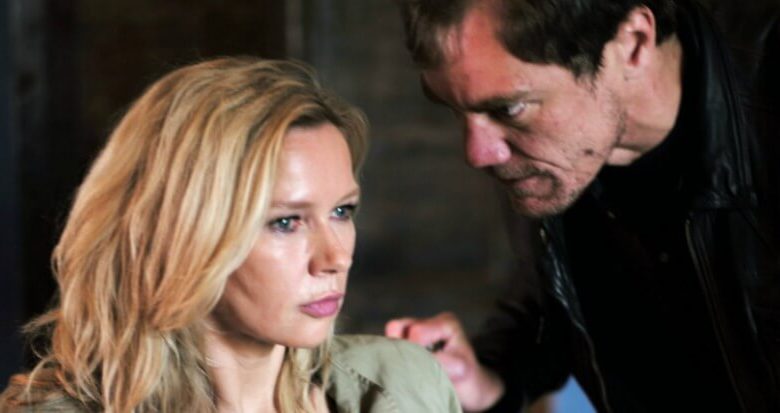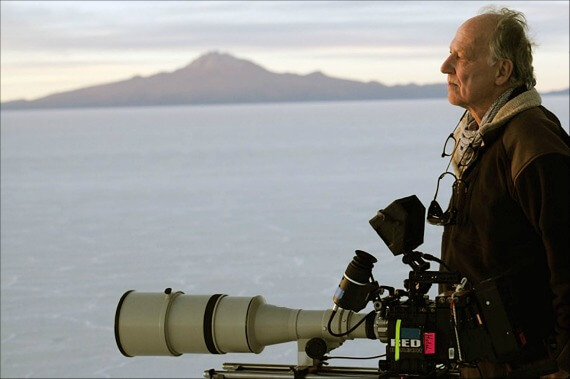
Is Werner Herzog putting us on?
It wouldn’t be the first time the great German filmmaker played a prank on his audience. “Salt and Fire,” Herzog’s latest film, is one of the few times where, rather than happily share the joke with the eccentric filmmaker, I walked away like a sourpuss.
The lovely Veronica Ferres stars as Laura Sommerfeld, a celebrated ecologist who boards a flight to investigate a disaster that took place in South America. She’s joined by two other scientists, one of whom is played by Gael Garcia Bernal. Upon landing, the scientists are kidnapped by a mysterious leader (Michael Shannon), whose motivations and overall scheme aren’t initially made clear.
Filmed in Bolivia, “Salt and Fire” fails to properly establish its premise, then tests audience goodwill with each passing minute.
FAST FACT: Werner Herzog first met future collaborator Klaus Kinski at the age of 13 when they both lived in the same German building.
Despite the cast, the acting is surprisingly terrible. Even with complicated long takes, it all feels stiff and awkwardly constructed. Shannon is worth seeing in just about any movie. Here, his intensity is wasted. It often appears like Shannon is reading his lines off-camera.
In other films, he’s brilliant, like a young Christopher Walken. Here, he recites his dialog in such an intriguingly robotic manner, I kept waiting for a big reveal that he’s playing a robot.
Spoiler: he isn’t.
Every bad movie has an irredeemable moment that sinks it, and “Salt and Fire” has more than a few. There’s Shannon’s theory about overweight UFO abductees, a jaw-droppingly silly (and still visually awesome) sequence involving the creation of the ultimate selfie and characters who suffer from debilitating diarrhea.
It’s hard to tell if that bit is meant to be played for laughs or not.
Herzog’s screenplay unleashes one groan inducing line after another. Here’s a sample:
“Truth is the only daughter of time.”
“The noblest place for a man to die is the place he dies the deadest.”
The biggest doozy is saved for a character introduced as wheelchair bound but later declares, “I only use the wheelchair when I’m tired of life.”
Oy vey.
The music in “Salt and Fire” is sometimes provided by strings and piano but the score often sounds like it was composed by an accordion or harmonium. Sitting through this may drive some people a little crazy. I had to force myself to finish it and had to keep reminding myself what a fan of Herzog I’ve always been.

There is a belated justification of the kidnapping in the last scene, and its pretty laughable. I suspect the plot overall matters less than the atmosphere and ideas Herzog wants to wash over us. Still, even if this meant as a just-kidding exercise, a firm grip on audience interest, building character and developing the story points is never established.
Jean Luc-Godard’s brilliant 1985 mood “Detective,” was an oh-so-cool mood and genre throwback that waited to the last minute to nonchalantly wrap up the mystery. Godard’s deconstruction of thriller and noir films concluded with his typically cynical, playful suggestion that it’s just a movie, no big deal. A similarly cheeky sensibility is at hand here but Herzog’s experiment frustrates more than it tantalizes.
Long after most will have given up and it seems the movie is beyond repair, Herzog’s third act offers a dread and awe-inducing sequence involving desert survival. This portion of the film reminded me of Wenders’ extraordinary “Until the End of the World” and is the only successful part of the entire film.
Its followed by a weak wrap-up that unfortunately stinks as much as the first and second act. Despite an earnest ecological message, some stunning cinematography and a few compelling bits, “Salt and Fire” is a maddening goof.
Herzog is a fearless genius, one of the key figures of New German Cinema (other notable filmmakers include Wim Wenders and Rainer Fassbinder, the post French New Wave-period that led to internationally embraced masterpieces like “Alice in the Cities,” “Berlin Alexanderplatz” and “Fitzcarraldo.”)
Herzog directed the latter film, in which a steamboat is transported up a mountain (a spectacle actually carried out for real during filming). Other un-missable Herzog works include classics like “Aguirre, Wrath of God,” “Nosferatu The Vampire,” “The Enigma of Kaspar Hauser,” “Invincible,” “Rescue Dawn” and “Bad Lieutenant: Port of Call New Orleans,” all offbeat, madly risk-taking, cleverly cracked and quite perfect.
His extraordinary documentaries include “Grizzly Man,” “My Best Fiend,” “The White Diamond” and “Into the Abyss,” all immersive, personable and brave explorations of life’s wonders and horrors.
Herzog is a true original and a justifiably celebrated film artist whose works are met with great anticipation.
So … what happened with “Salt and Fire”?
It reminded me of Herzog’s “The Wild Blue Yonder,” in which Brad Dourif plays an alien prone to give long winded monologues (either improvised by the actor or provided by Herzog). It’s a baffling, unsuccessful film that, nevertheless, has astonishing footage taken from inside the International Space Station. I’ve never forgotten the visuals but have placed the rest of the film in the back of my mind. Equally lop-sided was Herzog’s predictably odd pairing with David Lynch, “My Son, My Son, What Have Ye Done?,” which also starred Shannon.
When Herzog’s films click, they unleash valuable, unique perspectives on humanity, shape unpredictable characters and narratives and offer riches of visual splendor. His worst films, on the other hand, are akin to witnessing clown cars collide violently, with red nosed, polka-dot pants-wearing survivors stumbling around, bloodied and dumbstruck.
When Herzog connects with the material, he’s a master. When he fumbles, it’s like watching a brilliant stand-up unleash a whoopee cushion then dash off the stage, giggling. Herzog may be pulling my leg this time but he also wasted my time. “Salt and Fire” is like a mirage, half formed, barely there and offering nothing before it dissolves into hot air.

Sad. Herzog’s list of avice for filmmakers is one of the all-time greatest pieces of insight on the art of filmmaking EVER. And when he’s good, he’s great.